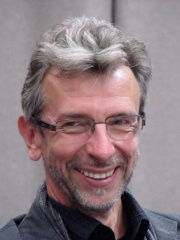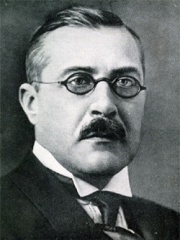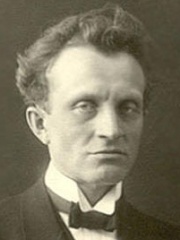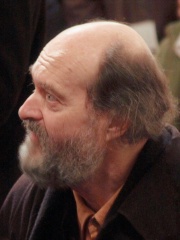
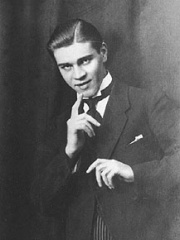
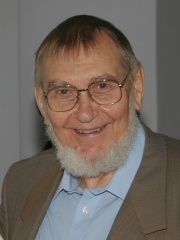
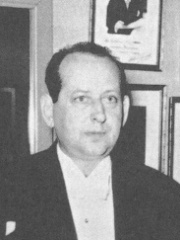
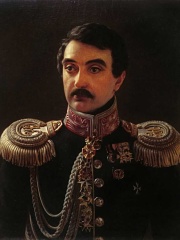
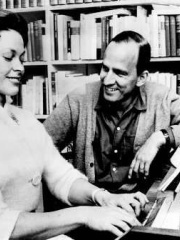
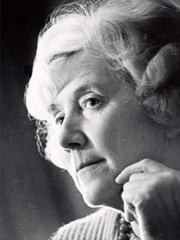
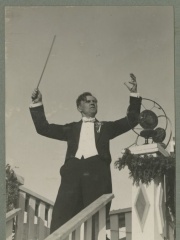
The Most Famous
COMPOSERS from Estonia
Top 10
The following people are considered by Pantheon to be the top 10 most legendary Estonian Composers of all time. This list of famous Estonian Composers is sorted by HPI (Historical Popularity Index), a metric that aggregates information on a biography's online popularity. Visit the rankings page to view the entire list of Estonian Composers.

1. Arvo Pärt (b. 1935)
With an HPI of 75.13, Arvo Pärt is the most famous Estonian Composer. His biography has been translated into 55 different languages on wikipedia.
Arvo Pärt (Estonian pronunciation: [ˈɑrvo ˈpært]; born 11 September 1935) is an Estonian composer of contemporary classical music. Since the late 1970s, Pärt has worked in a minimalist style that employs tintinnabuli, a compositional technique he invented. Pärt's music is in part inspired by Gregorian chant. His most performed works include Fratres (1977), Spiegel im Spiegel (1978), and Für Alina (1976). From 2011 to 2018, and again in 2022, Pärt was the most performed living composer in the world, and the second most performed in 2019, after John Williams. The Arvo Pärt Centre, in Laulasmaa, was opened to the public in 2018.

2. Evald Aav (1900 - 1939)
With an HPI of 62.78, Evald Aav is the 2nd most famous Estonian Composer. His biography has been translated into 28 different languages.
Evald Aav (7 March [O.S. 22 February] 1900 – 21 March 1939) was an Estonian composer born in Tallinn, Governorate of Estonia, Russian Empire. He studied music composition there with Artur Kapp and wrote primarily vocal music to words in the Estonian language. In 1928 he composed the first national Estonian opera, Vikerlased (The Vikings). The opera premiered in Tallinn on 8 September 1928. He modelled his style of composition after Tchaikovsky.Aav was married to opera singer Ida Loo-Talvari from 1926 until 1937 when the couple divorced.

3. Veljo Tormis (1930 - 2017)
With an HPI of 61.96, Veljo Tormis is the 3rd most famous Estonian Composer. His biography has been translated into 24 different languages.
Veljo Tormis (7 August 1930 – 21 January 2017) was an Estonian composer, regarded as one of the great contemporary choral composers and one of the most important composers of the 20th century in Estonia. Internationally, his fame arises chiefly from his extensive body of choral music, which exceeds 500 individual choral songs, most of it a cappella. The great majority of these pieces are based on traditional ancient Estonian folksongs (regilaulud), either textually, melodically, or merely stylistically. His composition most often performed outside Estonia, Curse Upon Iron (Raua needmine, 1972), invokes ancient Shamanistic traditions to construct an allegory about the evils of war. Some of his works were banned by the Soviet government, but because folk music was fundamental to his style most of his compositions were accepted by the censors. More recently, Tormis' works have been performed and recorded by Tõnu Kaljuste with the Estonian Philharmonic Chamber Choir, and others. In the 1990s, Tormis began to receive commissions from some a cappella groups as the King's Singers and the Hilliard Ensemble. Tormis famously said of his settings of traditional melodies and verse: "It is not I who makes use of folk music, it is folk music that makes use of me." His work demonstrates his conviction that traditional Estonian and other Balto-Finnic music represents a treasure which must be guarded and nourished, and that culture may be kept alive through the medium of song.

4. Eduard Tubin (1905 - 1982)
With an HPI of 61.14, Eduard Tubin is the 4th most famous Estonian Composer. His biography has been translated into 23 different languages.
Eduard Tubin (18 June [O.S. 5 June] 1905 – 17 November 1982) was an Estonian composer, conductor, and choreographer.
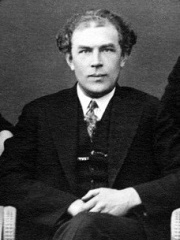
5. Heino Eller (1887 - 1970)
With an HPI of 59.90, Heino Eller is the 5th most famous Estonian Composer. His biography has been translated into 21 different languages.
Heino Eller (7 March 1887 – 16 June 1970) was an Estonian composer and pedagogue, known as the founder of contemporary Estonian symphonic music.

6. Alexei Lvov (1798 - 1870)
With an HPI of 59.78, Alexei Lvov is the 6th most famous Estonian Composer. His biography has been translated into 21 different languages.
Alexei Fyodorovich Lvov (Russian: Алексей Фёдорович Львов; 5 June [O.S. 25 May] 1798 – 28 December [O.S. 16 December] 1870) was a Russian composer, best known for the composition of the imperial-era Russian national anthem, God Save the Tsar.

7. Käbi Laretei (1922 - 2014)
With an HPI of 59.57, Käbi Laretei is the 7th most famous Estonian Composer. Her biography has been translated into 17 different languages.
Käbi Alma Laretei (14 July 1922 – 31 October 2014) was an Estonian-Swedish concert pianist. Her father Heinrich Laretei was a diplomat in the service of the Republic of Estonia as ambassador to Sweden; when the Soviet Union occupied Estonia in 1940, the family did not return to Estonia. Her piano teacher was Maria-Luisa Strub-Moresco, who had an indirect influence on the artistic choices of Laretei's later husband, Ingmar Bergman. Laretei had a long and distinguished career as a pianist, and in the 1960s she played to packed halls in the United Kingdom, Sweden, West Germany, and the United States, including Carnegie Hall. From 1950 to 1959, Laretei was married to Gunnar Staern, with whom she had a daughter, Linda (born 1955). Laretei is also known for her marriage to and professional collaborations with film director Ingmar Bergman; Laretei was his fourth wife. They met in the late 1950s, and were married in 1959. She introduced Bergman to a variety of music, some of which he would use in film scores. They divorced in 1969, though the marriage was effectively over by 1966. His 1961 film Through a Glass Darkly is dedicated to Laretei. They had a son, Daniel Bergman (born 1962), who is also a film director. Laretei worked with Igor Stravinsky and Paul Hindemith. She continued to play in concert and give musical consultations on the set of some of her former husband's films and even appears playing the piano in a scene of Fanny and Alexander. She recorded piano passages that appear diegetically in Bergman's films, such as Autumn Sonata and The Magic Flute. She took an early interest in the TV medium, hosted many programmes on literature and music on Swedish TV and, starting with En bit jord (1976; "A lump of earth"), published a number of books on life and music, the last being Såsom i en översättning (2004; "As in a translation", the title being a paraphrase on "Through a Glass Darkly" (Såsom i en spegel)). Moreover, she has been the subject of numerous television and film documentaries. She was awarded Estonia's Order of the National Coat of Arms, 3rd Class in 1998. She died on 31 October 2014 at the age of 92.

8. Ester Mägi (1922 - 2021)
With an HPI of 59.08, Ester Mägi is the 8th most famous Estonian Composer. Her biography has been translated into 20 different languages.
Ester Mägi (10 January 1922 – 14 May 2021) was an Estonian composer.

9. Juhan Aavik (1884 - 1982)
With an HPI of 58.57, Juhan Aavik is the 9th most famous Estonian Composer. His biography has been translated into 17 different languages.
Juhan Aavik (29 January 1884 – 26 November 1982) was an Estonian composer. Aavik was born in Holstre, Kreis Fellin, Governorate of Livonia, Russian Empire. He studied music composition at the Saint Petersburg Conservatory. He later served as a conductor in Tartu, Governorate of Livonia (1911–1925), a musical conservatory professor and director in Tallinn (1928–1944), and an Estonian song festival conductor in Sweden (1948–1961) (after arriving there in 1944). He wrote nearly 200 Opus numbers, among them two symphonies; a Cello concerto (1949); a Double bass Concerto (1950); a Piano trio (1957); a Requiem (1959); and various choral works, songs and chamber music. In Stockholm at age 81 (1965–1969), he published a history of Estonian music in four volumes. He died in Stockholm.
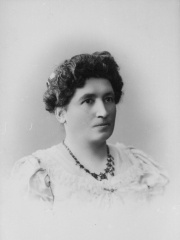
10. Miina Härma (1864 - 1941)
With an HPI of 58.44, Miina Härma is the 10th most famous Estonian Composer. Her biography has been translated into 28 different languages.
Miina Härma (née Hermann; 9 February 1864 – 16 November 1941) was an Estonian composer, organist, choir director, and music teacher, known for being Estonia's first professional female composer and organist.
People
Pantheon has 18 people classified as Estonian composers born between 1798 and 1959. Of these 18, 2 (11.11%) of them are still alive today. The most famous living Estonian composers include Arvo Pärt, and Erkki-Sven Tüür. The most famous deceased Estonian composers include Evald Aav, Veljo Tormis, and Eduard Tubin.
Living Estonian Composers
Go to all RankingsDeceased Estonian Composers
Go to all RankingsEvald Aav
1900 - 1939
HPI: 62.78
Veljo Tormis
1930 - 2017
HPI: 61.96
Eduard Tubin
1905 - 1982
HPI: 61.14
Heino Eller
1887 - 1970
HPI: 59.90
Alexei Lvov
1798 - 1870
HPI: 59.78
Käbi Laretei
1922 - 2014
HPI: 59.57
Ester Mägi
1922 - 2021
HPI: 59.08
Juhan Aavik
1884 - 1982
HPI: 58.57
Miina Härma
1864 - 1941
HPI: 58.44
Artur Kapp
1878 - 1952
HPI: 58.16
Rudolf Tobias
1873 - 1918
HPI: 57.63
Gustav Ernesaks
1908 - 1993
HPI: 57.49
Overlapping Lives
Which Composers were alive at the same time? This visualization shows the lifespans of the 15 most globally memorable Composers since 1700.

